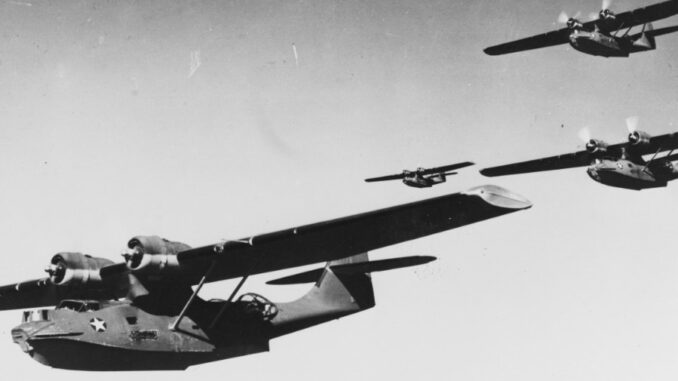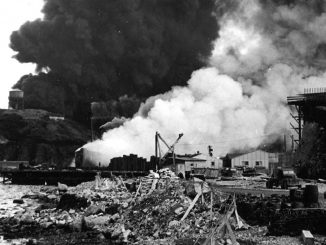
For the Japanese, the only bright spot in the disastrous MI-AL Operation was the capture of the tiny Aleutian Islands of Kiska and Attu – the only pieces of American territory to fall into enemy hands during the war. The two islands had limited military value but would serve as advanced outposts to protect the northern extremes of the Japanese Home Islands, providing warning of any encroachment by American forces. Therefore, it was assumed, the Americans would not be able to launch any further carrier raids on Tokyo or other important locations.
Kiska was home to a small US Navy weather and radio station, manned by a detachment of ten men, and Attu was inhabited by less than 50 natives living in Chicagof village. On Sunday the 7th of June, the Japanese began landing on both Attu and Kiska. Both islands fell to the Japanese in a matter of hours with little struggle, although an American teacher was killed during the occupation of Attu. An American naval task force under RAdm Robert Theobald was unable to interfere due to heavy fog, which also prevented Army and Navy bombers from finding the Japanese naval forces. This was not helped by the choice of patrol sectors, the Americans concentrating on the Bering Sea north of the Aleutians when the Japanese were well to the south. For three days after the initial landings American aircraft criss-crossed the area but failed to sight anything due to the heavy fog – Hirohito’s new secret weapon. All the while the Japanese offloaded more military hardware and supplies, including anti-aircraft batteries which were sited to protect the key anchorages of Kiska and Attu and elements of the Toko Kokutai with H6K flying boats.
Finally, on the 10th of June an AAF LB-30 bomber overflow Kiska harbour, spotted ships anchored offshore, and was fired upon when it approached for a closer look. This news of the occupation of Kiska was confirmed shortly afterwards when a Navy PBY overflew the island and also reported the presence of Japanese warships. The presence of the enemy on American soil galvanised the high command, but with limited ground troops in the area the only option for the present was to launch an air offensive – and so Admiral Nimitz flashed orders to Patrol Wing 4 to ‘bomb the enemy out of Kiska’. PatWing-4, commanded by Capt Leslie Gehres, consisted of four squadrons of PBYs, including the newly-arrived VP-43 with ASE-equipped aircraft. All of the PBYs would be serviced by the tender Gillis, which was moored in Nazan Bay off Adka island.
The Navy would be joined in the offensive on Kiska by the Army Air Forces 36th Bomb Squadron, with B-17s, and the newly arrived 21st BS with B-24s. The weather on the 11th of June was good but mechanical problems affected the B-17s, and so the 21st BS took the lead with five B-24s heading for Kiska from Cold Bay. The effort was led personally by LtCol William O. Eareckson, commanding officer of the 28th Composite Group and the most senior AAF officer in the region. The bombers received a very hot reception from the Japanese who were, by now, well dug-in. The lead ship piloted by Capt Jack Todd took a direct hit in the bomb bay just as the approach began, and exploded, destroying the B-24 and damaging two others in the formation. All the bombs landed harmlessly in Kiska Bay, just as the Navy’s PBYs arrived. The PatWing-4 men dived through cloud to attack from just 1,000ft, scoring a damaging hit on the destroyer Hibiki before making their escape with three crewmen killed. Finally, hours later, the tardy 36th BS B-17s arrived – they came in singly, at the low level of 3,000ft. The Japanese AA guns did not react in time and before long enormous geysers of water erupted around two cruisers and a destroyer as the Americans released their weapons. The five Fortresses escaped and claimed hits to all 3 ships, but recon photos revealed that all had in fact been near-missed – the warships all survived unscathed.
As soon as the PBYs straggled in to Nazan Bay they were refuelled, bombed-up, and sent back to Kiska, in a routine that continued for the next three days. The Catalina had never been designed for this kind of job: it was a slow, ungainly aircraft, and it lacked the structural strength to act as a dive bomber, as it was now called upon to do. Whenever possible the PBYs attacked out of the overcast, limiting the time that the Japanese anti-aircraft crews had to react to their arrival. None of the aircraft had bombsights so the pilots dropped their payloads using ‘seaman’s eye’, which meant that the bombing was generally inaccurate. But the crews nevertheless stuck to their task, repeatedly suffering damage to their PBYs that took the machines out of commission. One Catalina was lost when its parasol wing sheared off pulling out of a dive, but that turned out to be the only aircraft lost during the raids. Many more suffered severe damage and crew losses, but managed to stagger back to Adka.
After three days of bombing the Gillis ran out of bombs and fuel for the PBYs, bringing an end to the Navy’s blitz. The decision was made to evacuate the small village on Adka off which the Gillis had been moored, most of the population leaving with the tender. Additional flights by PBYs brought out the remaining villagers, just hours before three H6Ks from the Toko Ku bombed the settlement having found no military targets remaining. PatWing-4 was also called upon to evacuate the crews of several weather stations and villages on minor outlying islands as it looked like the Japanese would consolidate their hold on the area.
The Army Air Force kept up the effort. LtCol Eareckson again led heavy bombers to Kiska on the 12th, this time taking his charges in at 1,200ft to ensure better bombing results. Hits were claimed on a heavy cruiser. More low-level efforts followed on the next two days, the last of which was opposed by floatplanes which damaged two of the B-17s. After a break imposed by appalling weather, Eareckson again took his heavies back Kiska on the 15th, this time attacking from the relatively high altitude of 14,000ft. On this occasion the bombers were effective, landing several hits on the cargo ship Nissan Maru. Three days later Nissan Maru was hit again, this time sustaining heavy damage. Set afire, the ship soon sank to the bottom of Kiska Harbor. In return a single B-24 was shot down, but the crew was rescued by a Navy PBY.
The prevailing weather conditions in the Aleutians proved to be the dominant factor in the summer of 1942. The weather dominated almost all tactical plans, often forcing postponements and cancellations of attacks on the Japanese. Conditions were so bad that on occasion bombers had to estimate their location by spotting the peak of Kiska volcano above the cloud layer, and drop their bombs through the overcast by stopwatch. Naturally, bombing results were abysmal. As the weather closed in there was an obvious drop off in the intensity of the effort. With the Navy PBYs back to searching, and Army bombers struggling to find the targets let alone hit them in the face of fighter opposition, there was little prospect of ‘bombing the enemy out of Kiska’. The realities of trying to fight a war in one of the most hostile climates on Earth were beginning to become apparent. In late June, Admiral Theobald issued orders to stop the blind-bombing, and missions stopped being daily occurrences.
On the 25th of June a PBY on a recon mission to Kiska came under attack by a floatplane. One gunner was killed by machine gun fire but the plane escaped to make its report. This established a pattern that was to continue for the next few months – American bombers attacked Kiska singly or in small groups, and Japanese floatplanes attempted to stop them. Aerial combat occurred occasionally, with the odd aircraft on either side shot down. One such instance took place on the 7th of July, when eight bombers were attacked by a new type of 250mph floatplane fighter. This was one of the first contacts with the A6M2-N, later codenamed ‘Rufe’, which was a variant of the Zero fighter fitted with floats to allow it to operate from seaplane bases. This unit was attached to the Toko Kokutai and would provide protection against the bombing raids on Kiska until a permanent airstrip could be built on the island. The Americans had their own new fighter, the twin-engine, 400mph P-38 Lightning which was introduced to combat by the 54th Fighter Squadron. On the 4th of August, a pair of patrolling P-38s found and shot down two H6K flying boats from the Toko Ku, the first victories for the Lightning.
At the end of August 1942 landings were made by American forces on Adak, an island about halfway between Dutch Harbor and Kiska . A US Army engineer aviation unit arrived and surveyed airfield locations, assessing that a marshy area could be drained and an airfield quickly constructed. This new facility allowed fighters based there to escort bombers all the way to Kiska. Within weeks P-38s and B-24 bombers were based at Adak, with missions continuing through the rest of 1942. However, the North Pacific Theatre was low down on the list for reinforcements, especially given the requirements of the Guadalcanal and North African operations. American forces in the area remained weak and there would be no major offensives until 1943.



While the encounter between P-38s and Toko Ku H6K flying boats on 4 August was confirmed by both sides, no Mavises were shot down.
Lieutenants Kenneth Ambrose and Stan Long, 54th Fighter Squadron, were notified about Japanese flying boats by a B-17 pilot Lt. McWilliams. He reported three Mavises flying in a V formation at 7,000 feet along the south coast of Atka toward Nazan Bay. Ambrose and Long climbed to 22,000 feet to be in a better position to intercept the flying boats. The Japanese spotted the two P-38s barreling down toward them. They turned west, broke formation and headed for the sea fog, the only cover available. Lt. Stan Long was the first to attack, firing at two seaplanes from the close range. The canopy of the one of the Mavises disintegrated. The two Lightning pilots then climbed for the altitude and Lt. Ambrose instructed Long: “Let’s concentrate on the outside one.” On the second pass, Ambrose succeeded in setting the left wing of the Japanese aircraft afire. The seaplane was observed heading out of control into the overcast extending up to 1,500 feet above the water. The other Mavis escaped. (John Cloe, “Aleutian Warriors”)
Below is translated ACA report of Toko Ku:
Two Mavises took off at 0320 (i)
They bombed Nazan Harbor at 0558(i)
They were intercepted by a P-38 at the same time.
They returned home at 0915
Four 250kg bombs were dropped.
90 rounds of 7.7mm were fired.
The Mavises returned home safely.
One of them got a bullet hole. (End)
Commander Ito in his post-war interrogation made no mention of losing any of his flying boats in aerial combat during Aleutian campaign.